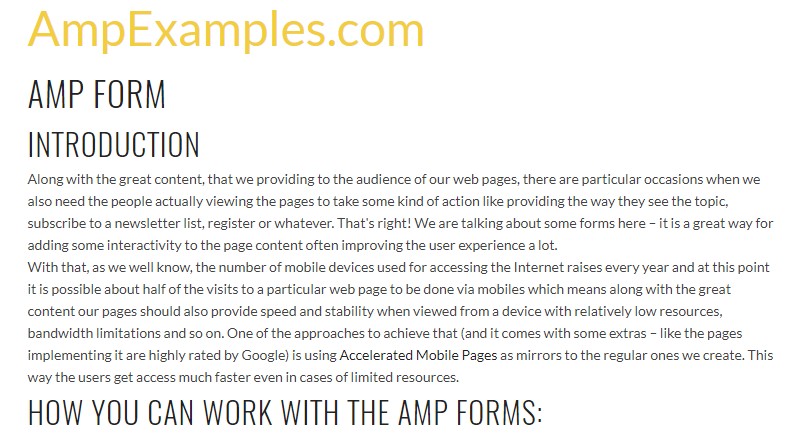Bootstrap Form Field
Intro
Bootstrap gives several form regulation looks, layout options, and custom elements for generating a wide variety of Bootstrap Form Input.
Forms supply the best treatment for obtaining several feedback from the visitors of our pages. In case that it's a simple connection or else subscription form including simply a handful of areas or a complicated and nicely thought examination the Bootstrap 4 structure got everything that is certainly wanted to perform the work and attain awesome responsive appearance.
By default in the Bootstrap framework the form aspects are styled to span the entire width of its own parent feature-- this becomes realized by selecting the .form-control class and using form builder software. The directions and lebels should really be wrapped into a parent element along with the .form-group class for effective spacing.
Bootstrap Form Inline commands
Bootstrap's form controls grow with regards to our Rebooted form looks with classes.
Employ these classes to opt into their customized display screens for a more consistent rendering all around internet browsers and tools . The example form listed here shows basic HTML form components that obtain improved looks directly from Bootstrap with extra classes.
Keep in mind, due to the fact that Bootstrap employs the HTML5 doctype, all inputs must have a type attribute.
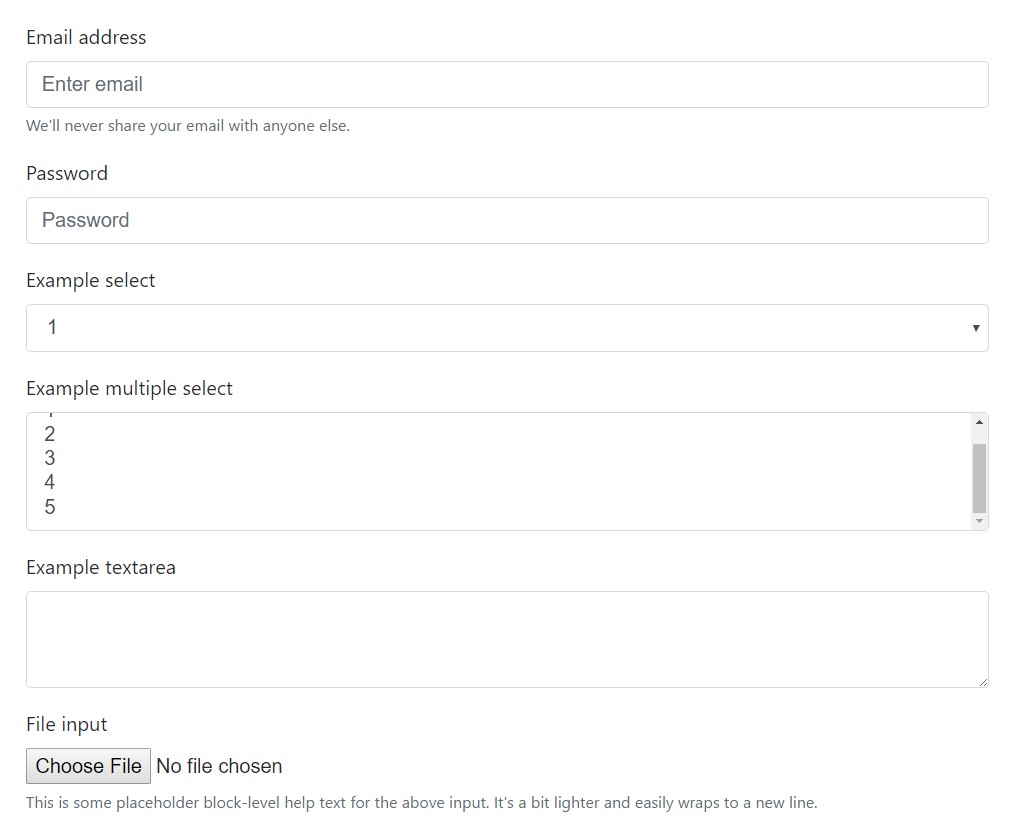

<form>
<div class="form-group">
<label for="exampleInputEmail1">Email address</label>
<input type="email" class="form-control" id="exampleInputEmail1" aria-describedby="emailHelp" placeholder="Enter email">
<small id="emailHelp" class="form-text text-muted">We'll never share your email with anyone else.</small>
</div>
<div class="form-group">
<label for="exampleInputPassword1">Password</label>
<input type="password" class="form-control" id="exampleInputPassword1" placeholder="Password">
</div>
<div class="form-group">
<label for="exampleSelect1">Example select</label>
<select class="form-control" id="exampleSelect1">
<option>1</option>
<option>2</option>
<option>3</option>
<option>4</option>
<option>5</option>
</select>
</div>
<div class="form-group">
<label for="exampleSelect2">Example multiple select</label>
<select multiple class="form-control" id="exampleSelect2">
<option>1</option>
<option>2</option>
<option>3</option>
<option>4</option>
<option>5</option>
</select>
</div>
<div class="form-group">
<label for="exampleTextarea">Example textarea</label>
<textarea class="form-control" id="exampleTextarea" rows="3"></textarea>
</div>
<div class="form-group">
<label for="exampleInputFile">File input</label>
<input type="file" class="form-control-file" id="exampleInputFile" aria-describedby="fileHelp">
<small id="fileHelp" class="form-text text-muted">This is some placeholder block-level help text for the above input. It's a bit lighter and easily wraps to a new line.</small>
</div>
<fieldset class="form-group">
<legend>Radio buttons</legend>
<div class="form-check">
<label class="form-check-label">
<input type="radio" class="form-check-input" name="optionsRadios" id="optionsRadios1" value="option1" checked>
Option one is this and that—be sure to include why it's great
</label>
</div>
<div class="form-check">
<label class="form-check-label">
<input type="radio" class="form-check-input" name="optionsRadios" id="optionsRadios2" value="option2">
Option two can be something else and selecting it will deselect option one
</label>
</div>
<div class="form-check disabled">
<label class="form-check-label">
<input type="radio" class="form-check-input" name="optionsRadios" id="optionsRadios3" value="option3" disabled>
Option three is disabled
</label>
</div>
</fieldset>
<div class="form-check">
<label class="form-check-label">
<input type="checkbox" class="form-check-input">
Check me out
</label>
</div>
<button type="submit" class="btn btn-primary">Submit</button>
</form>Below is a full catalogue of the particular Bootstrap Form Field controls maintained by Bootstrap as well as the classes which customise them. Special information is readily available for every group.
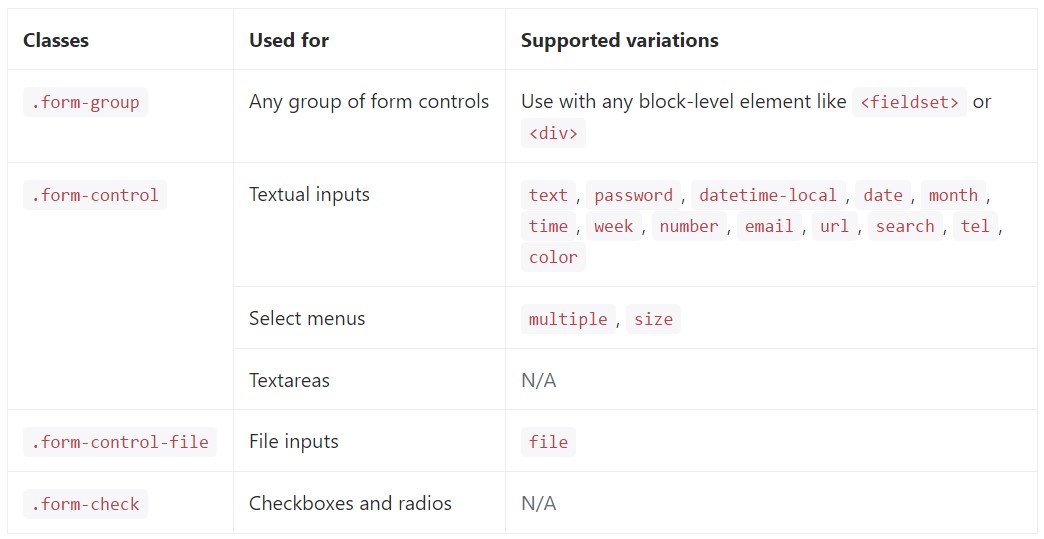
Textual inputs
Listed here are the good examples of .form-control related to each and every textual HTML5 <input> type.
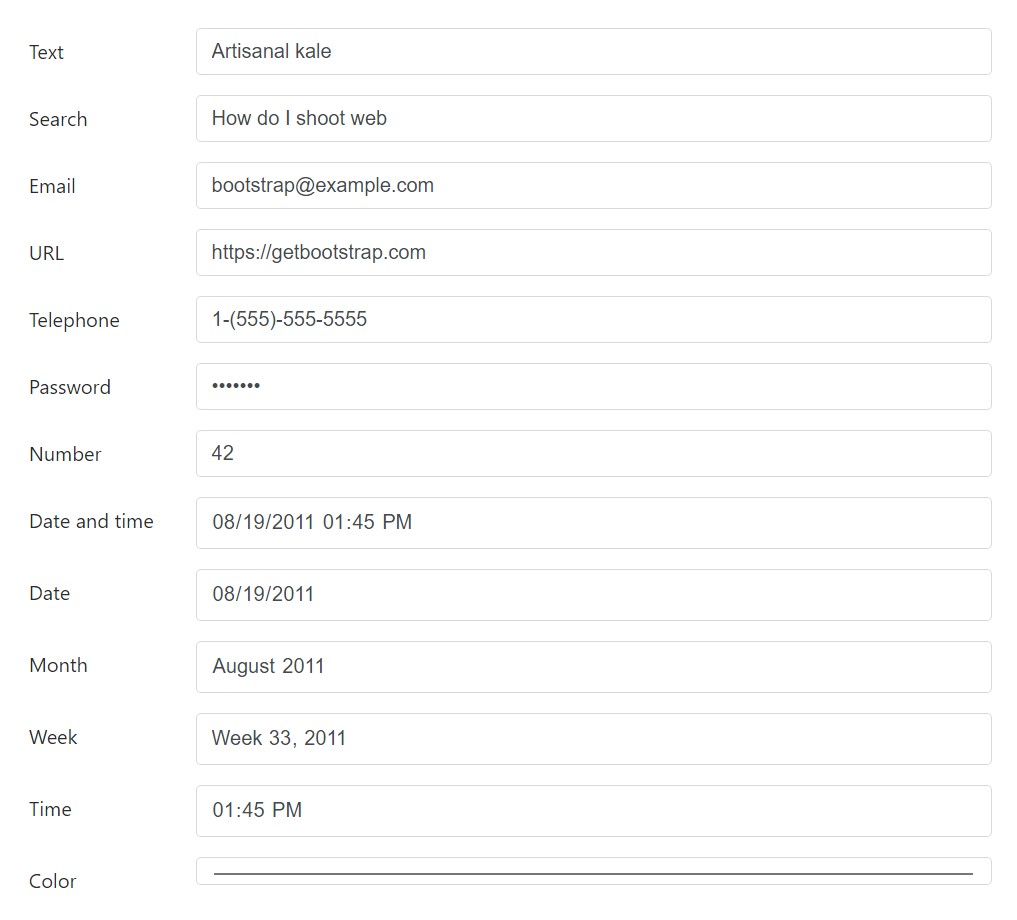
<div class="form-group row">
<label for="example-text-input" class="col-2 col-form-label">Text</label>
<div class="col-10">
<input class="form-control" type="text" value="Artisanal kale" id="example-text-input">
</div>
</div>
<div class="form-group row">
<label for="example-search-input" class="col-2 col-form-label">Search</label>
<div class="col-10">
<input class="form-control" type="search" value="How do I shoot web" id="example-search-input">
</div>
</div>
<div class="form-group row">
<label for="example-email-input" class="col-2 col-form-label">Email</label>
<div class="col-10">
<input class="form-control" type="email" value="[email protected]" id="example-email-input">
</div>
</div>
<div class="form-group row">
<label for="example-url-input" class="col-2 col-form-label">URL</label>
<div class="col-10">
<input class="form-control" type="url" value="https://getbootstrap.com" id="example-url-input">
</div>
</div>
<div class="form-group row">
<label for="example-tel-input" class="col-2 col-form-label">Telephone</label>
<div class="col-10">
<input class="form-control" type="tel" value="1-(555)-555-5555" id="example-tel-input">
</div>
</div>
<div class="form-group row">
<label for="example-password-input" class="col-2 col-form-label">Password</label>
<div class="col-10">
<input class="form-control" type="password" value="hunter2" id="example-password-input">
</div>
</div>
<div class="form-group row">
<label for="example-number-input" class="col-2 col-form-label">Number</label>
<div class="col-10">
<input class="form-control" type="number" value="42" id="example-number-input">
</div>
</div>
<div class="form-group row">
<label for="example-datetime-local-input" class="col-2 col-form-label">Date and time</label>
<div class="col-10">
<input class="form-control" type="datetime-local" value="2011-08-19T13:45:00" id="example-datetime-local-input">
</div>
</div>
<div class="form-group row">
<label for="example-date-input" class="col-2 col-form-label">Date</label>
<div class="col-10">
<input class="form-control" type="date" value="2011-08-19" id="example-date-input">
</div>
</div>
<div class="form-group row">
<label for="example-month-input" class="col-2 col-form-label">Month</label>
<div class="col-10">
<input class="form-control" type="month" value="2011-08" id="example-month-input">
</div>
</div>
<div class="form-group row">
<label for="example-week-input" class="col-2 col-form-label">Week</label>
<div class="col-10">
<input class="form-control" type="week" value="2011-W33" id="example-week-input">
</div>
</div>
<div class="form-group row">
<label for="example-time-input" class="col-2 col-form-label">Time</label>
<div class="col-10">
<input class="form-control" type="time" value="13:45:00" id="example-time-input">
</div>
</div>
<div class="form-group row">
<label for="example-color-input" class="col-2 col-form-label">Color</label>
<div class="col-10">
<input class="form-control" type="color" value="#563d7c" id="example-color-input">
</div>
</div>Form arrangements
Since Bootstrap uses display: block and width :100% to mostly all our form controls, forms will by default stack vertically. More classes can possibly be applied to differ this specific layout on a per-form basis.
Form groups
The .form-group class is the most convenient procedure to put in remarkable building to forms. Its only objective is to give margin-bottom around a label and manage pairing. Just as a bonus, given that it's a class you can easily apply it utilizing <fieldset>-s, <div>-s, or else pretty much some other component.

<form>
<div class="form-group">
<label for="formGroupExampleInput">Example label</label>
<input type="text" class="form-control" id="formGroupExampleInput" placeholder="Example input">
</div>
<div class="form-group">
<label for="formGroupExampleInput2">Another label</label>
<input type="text" class="form-control" id="formGroupExampleInput2" placeholder="Another input">
</div>
</form>Inline forms
Use the .form-inline class to display a variety of labels, form managements , and also buttons on a singular horizontal row. Form controls inside inline forms are different a little from their default status.
- Controls are display: flex, collapsing any kind of HTML white color area and making it possible for you to provide placement control including spacing plus flexbox utilities.
- Controls plus input groups obtain width: auto to defeat the Bootstrap default width: 100%.
- Controls exclusively appear inline within viewports that are at very least 576px vast to account for small viewports on mobile devices.
You may require to physically address the width and positioning of specific form controls together with spacing utilities ( just as revealed here) Lastly, be sure to always involve a <label> along with each and every form control, whether or not you have to disguise it directly from non-screenreader website visitors with a code.

<form class="form-inline">
<label class="sr-only" for="inlineFormInput">Name</label>
<input type="text" class="form-control mb-2 mr-sm-2 mb-sm-0" id="inlineFormInput" placeholder="Jane Doe">
<label class="sr-only" for="inlineFormInputGroup">Username</label>
<div class="input-group mb-2 mr-sm-2 mb-sm-0">
<div class="input-group-addon">@</div>
<input type="text" class="form-control" id="inlineFormInputGroup" placeholder="Username">
</div>
<div class="form-check mb-2 mr-sm-2 mb-sm-0">
<label class="form-check-label">
<input class="form-check-input" type="checkbox"> Remember me
</label>
</div>
<button type="submit" class="btn btn-primary">Submit</button>
</form>Custom-made form controls and selects are also sustained.

<form class="form-inline">
<label class="mr-sm-2" for="inlineFormCustomSelect">Preference</label>
<select class="custom-select mb-2 mr-sm-2 mb-sm-0" id="inlineFormCustomSelect">
<option selected>Choose...</option>
<option value="1">One</option>
<option value="2">Two</option>
<option value="3">Three</option>
</select>
<label class="custom-control custom-checkbox mb-2 mr-sm-2 mb-sm-0">
<input type="checkbox" class="custom-control-input">
<span class="custom-control-indicator"></span>
<span class="custom-control-description">Remember my preference</span>
</label>
<button type="submit" class="btn btn-primary">Submit</button>
</form>Alternatives to covered labels
Assistive modern technologies like screen readers are going to have difficulty with your forms in the case that you do not feature a label for every single input. For these kinds of inline forms, you have the ability to hide the labels working with the .sr-only class. There are actually even more alternative solutions of delivering a label for assistive technologies, like the aria-label, aria-labelledby or title attribute. If no one at all of these are present, assistive technologies may likely invoke utilizing the placeholder attribute, in case that available, still, take note that utilization of placeholder as a replacing for various other labelling approaches is definitely not advised.
Using the Grid
For even more organised form layouts that are additionally responsive, you have the ability to use Bootstrap's predefined grid classes as well as mixins to create horizontal forms. Bring in the .row class to form groups and apply the .col-*-* classes in order to define the width of your labels and controls.
Be sure to add .col-form-label to your <label>-s as well so they’re vertically centered with their associated form controls. For <legend> elements, you can use .col-form-legend to make them appear similar to regular <label> elements.
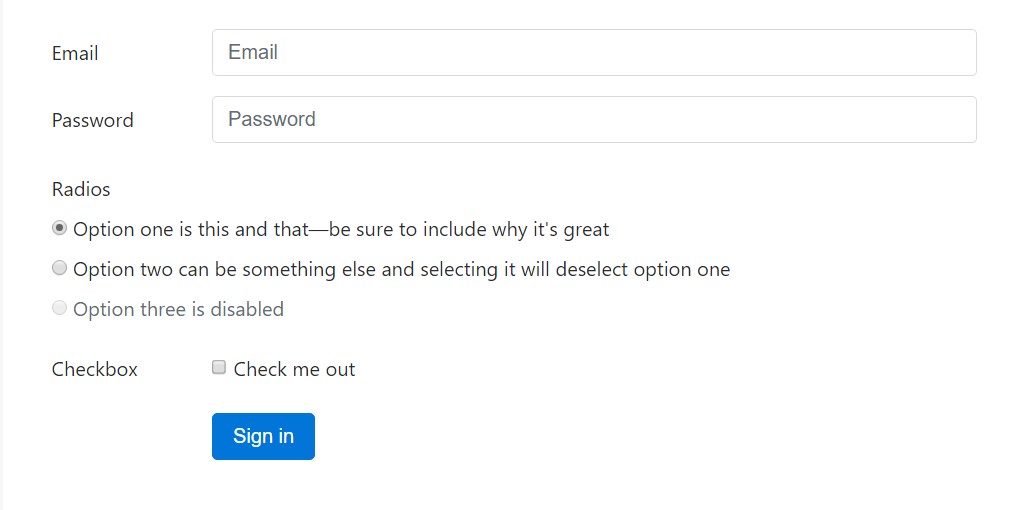
<div class="container">
<form>
<div class="form-group row">
<label for="inputEmail3" class="col-sm-2 col-form-label">Email</label>
<div class="col-sm-10">
<input type="email" class="form-control" id="inputEmail3" placeholder="Email">
</div>
</div>
<div class="form-group row">
<label for="inputPassword3" class="col-sm-2 col-form-label">Password</label>
<div class="col-sm-10">
<input type="password" class="form-control" id="inputPassword3" placeholder="Password">
</div>
</div>
<fieldset class="form-group row">
<legend class="col-form-legend col-sm-2">Radios</legend>
<div class="col-sm-10">
<div class="form-check">
<label class="form-check-label">
<input class="form-check-input" type="radio" name="gridRadios" id="gridRadios1" value="option1" checked>
Option one is this and that—be sure to include why it's great
</label>
</div>
<div class="form-check">
<label class="form-check-label">
<input class="form-check-input" type="radio" name="gridRadios" id="gridRadios2" value="option2">
Option two can be something else and selecting it will deselect option one
</label>
</div>
<div class="form-check disabled">
<label class="form-check-label">
<input class="form-check-input" type="radio" name="gridRadios" id="gridRadios3" value="option3" disabled>
Option three is disabled
</label>
</div>
</div>
</fieldset>
<div class="form-group row">
<label class="col-sm-2">Checkbox</label>
<div class="col-sm-10">
<div class="form-check">
<label class="form-check-label">
<input class="form-check-input" type="checkbox"> Check me out
</label>
</div>
</div>
</div>
<div class="form-group row">
<div class="offset-sm-2 col-sm-10">
<button type="submit" class="btn btn-primary">Sign in</button>
</div>
</div>
</form>
</div>Grid-based form configurations in addition sustain small and big inputs.

<div class="container">
<form>
<div class="form-group row">
<label for="lgFormGroupInput" class="col-sm-2 col-form-label col-form-label-lg">Email</label>
<div class="col-sm-10">
<input type="email" class="form-control form-control-lg" id="lgFormGroupInput" placeholder="[email protected]">
</div>
</div>
<div class="form-group row">
<label for="smFormGroupInput" class="col-sm-2 col-form-label col-form-label-sm">Email</label>
<div class="col-sm-10">
<input type="email" class="form-control form-control-sm" id="smFormGroupInput" placeholder="[email protected]">
</div>
</div>
</form>
</div>Checkboxes and radios
Default radios and checkboxes are upgraded upon with the help of .form-check, a specific class for each input types that increases the layout and actions of their HTML elements. Checkboxes are for choosing one as well as a handful of choices inside a selection, when radios are for selecting one choice from numerous.
Disabled checkboxes and radios are provided, but to provide a not-allowed cursor on hover of the parent <label>, you'll ought to put in the .disabled class to the parent .form-check. The disabled class is going to at the same time lighten the text message coloration to help reveal the input's state.
Each and every checkbox and radio is wrapped within a <label> because of three factors:
- It delivers a greater hit areas for checking the control.
- It grants a semantic and valuable wrapper to assist us removed and replace the default <input>-s.
- It leads to the state of the <input> automatically, showing no JavaScript is required.
We conceal the default <input> plus opacity and apply the .custom-control-indicator to set up a new unique form sign in its place. Unfortunately we cannot develop a custom-made one from just the <input> due to the fact that CSS's content does not work on that element..
We employ the relative selector (~) for every our <input> states-- like : checked-- to efficiently style our custom form indicator . When integrated with the .custom-control-description class, we can easily likewise format the content for each and every item formed on the <input>-s state.
In the checked states, we use base64 embedded SVG icons from Open Iconic. This provides us the best control for styling and positioning across browsers and devices.
Checkboxes

<label class="custom-control custom-checkbox">
<input type="checkbox" class="custom-control-input">
<span class="custom-control-indicator"></span>
<span class="custom-control-description">Check this custom checkbox</span>
</label>Custom checkboxes have the ability to additionally work with the : indeterminate pseudo class once manually fixed through JavaScript (there is definitely no available HTML attribute for indicating it).

In the event that you're working with jQuery, something like this should really do the trick:
$('.your-checkbox').prop('indeterminate', true)Radios

<label class="custom-control custom-radio">
<input id="radio1" name="radio" type="radio" class="custom-control-input">
<span class="custom-control-indicator"></span>
<span class="custom-control-description">Toggle this custom radio</span>
</label>
<label class="custom-control custom-radio">
<input id="radio2" name="radio" type="radio" class="custom-control-input">
<span class="custom-control-indicator"></span>
<span class="custom-control-description">Or toggle this other custom radio</span>
</label>Default (stacked)
By default, any number of checkboxes and radios that are definitely immediate sibling will be vertically loaded and also properly spaced by using .form-check.

<div class="form-check">
<label class="form-check-label">
<input class="form-check-input" type="checkbox" value="">
Option one is this and that—be sure to include why it's great
</label>
</div>
<div class="form-check disabled">
<label class="form-check-label">
<input class="form-check-input" type="checkbox" value="" disabled>
Option two is disabled
</label>
</div>
<div class="form-check">
<label class="form-check-label">
<input class="form-check-input" type="radio" name="exampleRadios" id="exampleRadios1" value="option1" checked>
Option one is this and that—be sure to include why it's great
</label>
</div>
<div class="form-check">
<label class="form-check-label">
<input class="form-check-input" type="radio" name="exampleRadios" id="exampleRadios2" value="option2">
Option two can be something else and selecting it will deselect option one
</label>
</div>
<div class="form-check disabled">
<label class="form-check-label">
<input class="form-check-input" type="radio" name="exampleRadios" id="exampleRadios3" value="option3" disabled>
Option three is disabled
</label>
</div>Inline
Group checkboxes or else radios on the same horizontal row simply by incorporating .form-check-inline to every .form-check.

<div class="form-check form-check-inline">
<label class="form-check-label">
<input class="form-check-input" type="checkbox" id="inlineCheckbox1" value="option1"> 1
</label>
</div>
<div class="form-check form-check-inline">
<label class="form-check-label">
<input class="form-check-input" type="checkbox" id="inlineCheckbox2" value="option2"> 2
</label>
</div>
<div class="form-check form-check-inline disabled">
<label class="form-check-label">
<input class="form-check-input" type="checkbox" id="inlineCheckbox3" value="option3" disabled> 3
</label>
</div>
<div class="form-check form-check-inline">
<label class="form-check-label">
<input class="form-check-input" type="radio" name="inlineRadioOptions" id="inlineRadio1" value="option1"> 1
</label>
</div>
<div class="form-check form-check-inline">
<label class="form-check-label">
<input class="form-check-input" type="radio" name="inlineRadioOptions" id="inlineRadio2" value="option2"> 2
</label>
</div>
<div class="form-check form-check-inline disabled">
<label class="form-check-label">
<input class="form-check-input" type="radio" name="inlineRadioOptions" id="inlineRadio3" value="option3" disabled> 3
</label>
</div>With no labels
You really should not possess a text inside the <label>, the input is arranged as you would certainly need. Right now only deals with non-inline checkboxes and radios. Bear in mind to currently supply some kind of label for assistive technologies ( as an example, applying aria-label).

<div class="form-check">
<label class="form-check-label">
<input class="form-check-input" type="checkbox" id="blankCheckbox" value="option1" aria-label="...">
</label>
</div>
<div class="form-check">
<label class="form-check-label">
<input class="form-check-input" type="radio" name="blankRadio" id="blankRadio1" value="option1" aria-label="...">
</label>
</div>Static directions
In the event that you require to set plain text beside a form label inside a form, use the .form-control-static class on an element of your solution.

<form>
<div class="form-group row">
<label class="col-sm-2 col-form-label">Email</label>
<div class="col-sm-10">
<p class="form-control-static">[email protected]</p>
</div>
</div>
<div class="form-group row">
<label for="inputPassword" class="col-sm-2 col-form-label">Password</label>
<div class="col-sm-10">
<input type="password" class="form-control" id="inputPassword" placeholder="Password">
</div>
</div>
</form>
<form class="form-inline">
<div class="form-group">
<label class="sr-only">Email</label>
<p class="form-control-static">[email protected]</p>
</div>
<div class="form-group mx-sm-3">
<label for="inputPassword2" class="sr-only">Password</label>
<input type="password" class="form-control" id="inputPassword2" placeholder="Password">
</div>
<button type="submit" class="btn btn-primary">Confirm identity</button>
</form>Disabled forms
Add in the disabled boolean attribute to an input to prevent user interactions. Disabled inputs appear lighter and put in a not-allowed pointer.
<input class="form-control" id="disabledInput" type="text" placeholder="Disabled input here..." disabled>Incorporate the disabled attribute to a <fieldset> to disable all of the commands within.
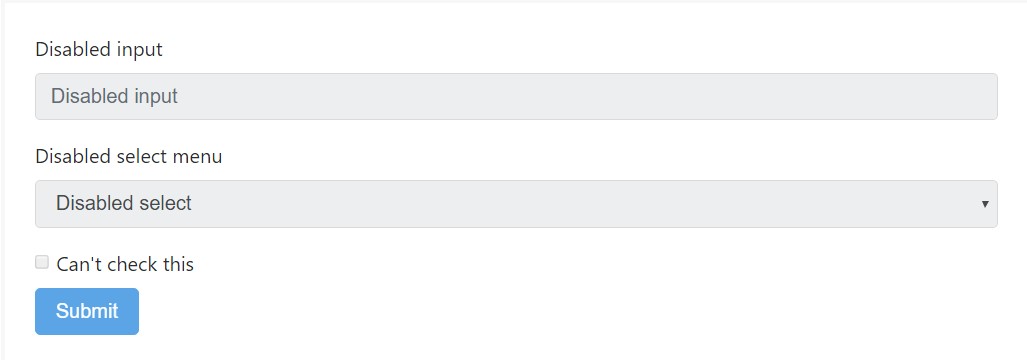
<form>
<fieldset disabled>
<div class="form-group">
<label for="disabledTextInput">Disabled input</label>
<input type="text" id="disabledTextInput" class="form-control" placeholder="Disabled input">
</div>
<div class="form-group">
<label for="disabledSelect">Disabled select menu</label>
<select id="disabledSelect" class="form-control">
<option>Disabled select</option>
</select>
</div>
<div class="checkbox">
<label>
<input type="checkbox"> Can't check this
</label>
</div>
<button type="submit" class="btn btn-primary">Submit</button>
</fieldset>
</form> Caution relating to hyperlink capabilities of <a>
By default, web browsers will definitely manage all native form controls (<input>, <select> plus <button> features) within a <fieldset disabled> as disabled, evading both the key-board plus mouse interplays on them. However, in the case that your form also features <a ... class="btn btn-*"> features, these will simply be brought a look of pointer-events: none. Being considered within the section relating to disabled state for buttons (and particularly in the sub-section for anchor elements ), this specific CSS feature is not really yet standardized and isn't totally maintained in Opera 18 and below, or else in Internet Explorer 11, and won't prevent computer keyboard users from having the opportunity to focus or else activate these urls. And so to remain safe, make use of custom made JavaScript to turn off such web links.
Cross-browser being compatible
As long as Bootstrap is going to employ these particular varieties within all web browsers, Internet Explorer 11 and below do not totally sustain the disabled attribute on a <fieldset>. Utilize custom-made JavaScript to turn off the fieldset in these kinds of browsers.
Readonly inputs
Bring in the readonly boolean attribute upon an input to avoid customization of the input's value. Read-only inputs show up lighter ( much like disabled inputs), but hold the regular cursor.

<input class="form-control" type="text" placeholder="Readonly input here…" readonly>Command proportions
Set up heights utilizing classes like .form-control-lg, and also set up widths working with grid column classes just like .col-lg-*.

<input class="form-control form-control-lg" type="text" placeholder=".form-control-lg">
<input class="form-control" type="text" placeholder="Default input">
<input class="form-control form-control-sm" type="text" placeholder=".form-control-sm">
<select class="form-control form-control-lg">
<option>Large select</option>
</select>
<select class="form-control">
<option>Default select</option>
</select>
<select class="form-control form-control-sm">
<option>Small select</option>
</select>Column size
Wrap inputs inside a grid columns, or else any type of custom-made parent element, to conveniently put in force the preferred widths.

<div class="row">
<div class="col-2">
<input type="text" class="form-control" placeholder=".col-2">
</div>
<div class="col-3">
<input type="text" class="form-control" placeholder=".col-3">
</div>
<div class="col-4">
<input type="text" class="form-control" placeholder=".col-4">
</div>
</div>Assist text message
The .help-block class is certainly cast off within the new version. In case you need to place some supplemental content to assist your visitors to better get around - work with the .form-text class alternatively. Bootstrap 4 has amazing built within validation styles for the form controls being employed . In this particular version the .has-feedback class has been simply dropped-- it's no longer needed to have with the introduction of the .form-control-danger, .form-control-warning and .form-control-success classes providing a tiny data icon directly inside the input fields.
Associating help message with form controls
Help text message must be explicitly associated with the form control it relates to applying the aria-describedby attribute. This will guarantee that the assistive technologies-- such as screen readers-- will announce this guide message if the user focuses or else gets in the control.
Block level
Block support message-- for below inputs or for a lot longer words of the help content-- can possibly be easily obtained with .form-text. This particular class provides display: block and includes a bit of top margin to get simple spacing from the inputs mentioned earlier.

<label for="inputPassword5">Password</label>
<input type="password" id="inputPassword5" class="form-control" aria-describedby="passwordHelpBlock">
<p id="passwordHelpBlock" class="form-text text-muted">
Your password must be 8-20 characters long, contain letters and numbers, and must not contain spaces, special characters, or emoji.
</p>Inline
Inline content can work with any sort of common inline HTML element (be it a , <span>, or else another).

<form class="form-inline">
<div class="form-group">
<label for="inputPassword4">Password</label>
<input type="password" id="inputPassword4" class="form-control mx-sm-3" aria-describedby="passwordHelpInline">
<small id="passwordHelpInline" class="text-muted">
Must be 8-20 characters long.
</small>
</div>
</form>Validation
Bootstrap provides validation styles for success, danger, and warning states on a large number of form controls.
Efficient ways to use
Here's a rundown of precisely how they perform:
- To use, add .has-warning, .has-danger, or .has-success to the parent element. Any .col-form-label, .form-control, as well as custom-made form component will acquire the validation formats.
- Contextual validation content, along with your usual form field help content, may be provided along with the utilization of .form-control-feedback. This text will adapt to the parent .has-* class. By default it really only includes a little bit of margin for spacing also a modified color for each and every state.
- Validation icons are url()-s designed by using Sass variables which are applied to background-image statements for each and every state.
- You may take your unique base64 PNGs or else SVGs simply by updating the Sass variables as well as recompiling.
- Icons are able to likewise be disabled completely through specifying the variables to none as well as commenting out the source Sass.
Determining states
Usually stating, you'll desire to utilize a particular state for certain types of feedback:
- Danger is effective for the time there's a blocking or possibly demanded field. A user has to notify this specific field successfully to submit the form.
- Warning performs well for input values that are in development, such as password strength, or else soft validation right before a user aims to submit a form.
- And lastly, success is suitable for situations each time you have per-field validation all throughout a form and desire to encourage a user throughout the whole fields.
For instances
Here are some samples of the previously mentioned classes at work. First off is your basic left-aligned fields with labels, help text, and validation messaging.
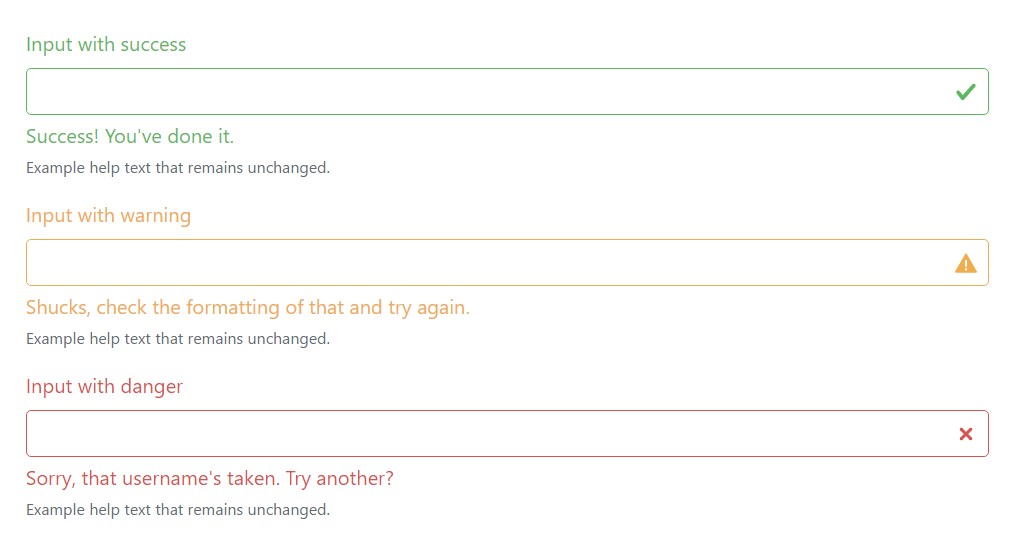
<div class="form-group has-success">
<label class="form-control-label" for="inputSuccess1">Input with success</label>
<input type="text" class="form-control form-control-success" id="inputSuccess1">
<div class="form-control-feedback">Success! You've done it.</div>
<small class="form-text text-muted">Example help text that remains unchanged.</small>
</div>
<div class="form-group has-warning">
<label class="form-control-label" for="inputWarning1">Input with warning</label>
<input type="text" class="form-control form-control-warning" id="inputWarning1">
<div class="form-control-feedback">Shucks, check the formatting of that and try again.</div>
<small class="form-text text-muted">Example help text that remains unchanged.</small>
</div>
<div class="form-group has-danger">
<label class="form-control-label" for="inputDanger1">Input with danger</label>
<input type="text" class="form-control form-control-danger" id="inputDanger1">
<div class="form-control-feedback">Sorry, that username's taken. Try another?</div>
<small class="form-text text-muted">Example help text that remains unchanged.</small>
</div>Those equal states have the ability to also be used with horizontal forms.
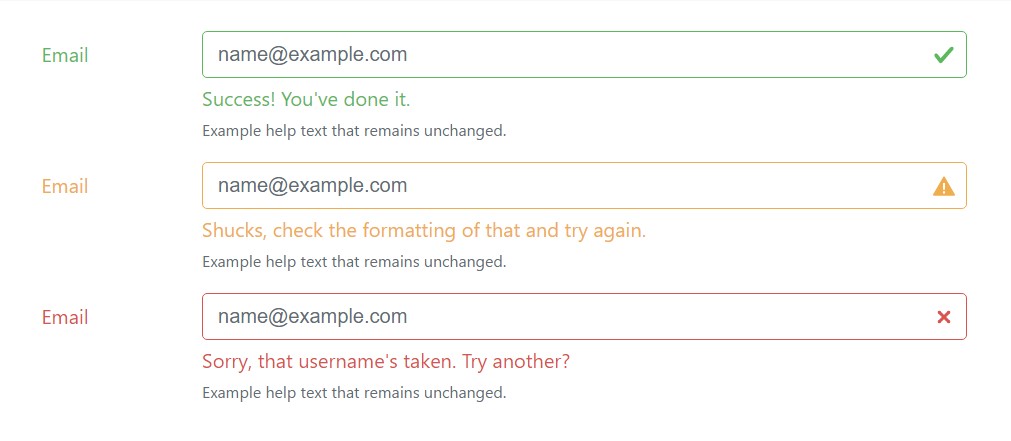
<div class="container">
<form>
<div class="form-group row has-success">
<label for="inputHorizontalSuccess" class="col-sm-2 col-form-label">Email</label>
<div class="col-sm-10">
<input type="email" class="form-control form-control-success" id="inputHorizontalSuccess" placeholder="[email protected]">
<div class="form-control-feedback">Success! You've done it.</div>
<small class="form-text text-muted">Example help text that remains unchanged.</small>
</div>
</div>
<div class="form-group row has-warning">
<label for="inputHorizontalWarning" class="col-sm-2 col-form-label">Email</label>
<div class="col-sm-10">
<input type="email" class="form-control form-control-warning" id="inputHorizontalWarning" placeholder="[email protected]">
<div class="form-control-feedback">Shucks, check the formatting of that and try again.</div>
<small class="form-text text-muted">Example help text that remains unchanged.</small>
</div>
</div>
<div class="form-group row has-danger">
<label for="inputHorizontalDnger" class="col-sm-2 col-form-label">Email</label>
<div class="col-sm-10">
<input type="email" class="form-control form-control-danger" id="inputHorizontalDnger" placeholder="[email protected]">
<div class="form-control-feedback">Sorry, that username's taken. Try another?</div>
<small class="form-text text-muted">Example help text that remains unchanged.</small>
</div>
</div>
</form>
</div>Checkboxes and radios are also sustained.

<div class="form-check has-success">
<label class="form-check-label">
<input type="checkbox" class="form-check-input" id="checkboxSuccess" value="option1">
Checkbox with success
</label>
</div>
<div class="form-check has-warning">
<label class="form-check-label">
<input type="checkbox" class="form-check-input" id="checkboxWarning" value="option1">
Checkbox with warning
</label>
</div>
<div class="form-check has-danger">
<label class="form-check-label">
<input type="checkbox" class="form-check-input" id="checkboxDanger" value="option1">
Checkbox with danger
</label>
</div>Custom-made forms
For much more customization and also cross browser stability, make use of Bootstrap absolutely custom form elements to remove and replace the internet browser defaults. They're constructed on top of attainable and semantic markup, so they are actually stable substitutes for any default form control.
Disabled
Customized radios and checkboxes can likewise be disabled . Include the disabled boolean attribute to the <input> and also the custom-made indicator and also label specification will be automatically designated.

<label class="custom-control custom-checkbox">
<input type="checkbox" class="custom-control-input" disabled>
<span class="custom-control-indicator"></span>
<span class="custom-control-description">Check this custom checkbox</span>
</label>
<label class="custom-control custom-radio">
<input id="radio3" name="radioDisabled" type="radio" class="custom-control-input" disabled>
<span class="custom-control-indicator"></span>
<span class="custom-control-description">Toggle this custom radio</span>
</label>Validation states
Bring in the other states to your customized forms together with Bootstrap validation classes.

<div class="form-group has-success">
<label class="custom-control custom-checkbox">
<input type="checkbox" class="custom-control-input">
<span class="custom-control-indicator"></span>
<span class="custom-control-description">Check this custom checkbox</span>
</label>
</div>
<div class="form-group has-warning">
<label class="custom-control custom-checkbox">
<input type="checkbox" class="custom-control-input">
<span class="custom-control-indicator"></span>
<span class="custom-control-description">Check this custom checkbox</span>
</label>
</div>
<div class="form-group has-danger mb-0">
<label class="custom-control custom-checkbox">
<input type="checkbox" class="custom-control-input">
<span class="custom-control-indicator"></span>
<span class="custom-control-description">Check this custom checkbox</span>
</label>
</div>Stacked
Custom checkboxes and radios are inline to start. Provide a parent with class .custom-controls-stacked to be sure every form control is on separate lines.

<div class="custom-controls-stacked">
<label class="custom-control custom-radio">
<input id="radioStacked1" name="radio-stacked" type="radio" class="custom-control-input">
<span class="custom-control-indicator"></span>
<span class="custom-control-description">Toggle this custom radio</span>
</label>
<label class="custom-control custom-radio">
<input id="radioStacked2" name="radio-stacked" type="radio" class="custom-control-input">
<span class="custom-control-indicator"></span>
<span class="custom-control-description">Or toggle this other custom radio</span>
</label>
</div>Select menu
Customized <select> menus require just a custom made class, .custom-select to produce the custom-made styles.

<select class="custom-select">
<option selected>Open this select menu</option>
<option value="1">One</option>
<option value="2">Two</option>
<option value="3">Three</option>
</select>File web browser
The file input is the much finest of the pack and need added JavaScript in case you 'd like to catch all of them up along with functional Choose file ... and selected file name text.
<label class="custom-file">
<input type="file" id="file" class="custom-file-input">
<span class="custom-file-control"></span>
</label>Here’s tips on how to use:
- We wrap the <input> in a <label> with the purpose that the custom control properly activates the file browser.
- We cover the default file <input> with opacity.
- We use : after to produce a customized background and directive (Choose file ...).
- We use :before to generate and position the Browser switch.
- We reveal a height on the <input> for appropriate spacing for surrounding content .
In shorts, it is really an entirely custom-made component, entirely developed using CSS.
Converting or else altering the strings
The : lang() pseudo-class is applied to allow easy adaptation of the "Browse" along with "Choose file ..." text into some other languages. Simply override or else add in entrances to the $ custom-file-text SCSS variable along with the associated language tag along with localized strings. The English strings may be modified similarly. As an example, here's how one might just incorporate a Spanish adaptation (Spanish's language code is es)
$custom-file-text: (
placeholder: (
en: "Choose file...",
es: "Seleccionar archivo..."
),
button-label: (
en: "Browse",
es: "Navegar"
)
);You'll need to set the language of your document (or subtree thereof) effectively in order for the correct content to be shown. This can be performed using the lang attribute or else the Content-Language HTTP header, with additional approaches.
Conclusions
Basically these are the new elements to the form components added in the current fourth edition of the Bootstrap framework. The entire thought is the classes got more user-friendly and specific for this reason-- much more simple to employ and also using the customized control features we can easily now get far more foreseeable appearance of the elements we involve in the website page we create. Right now everything that's left for us is determine the appropriate info we would likely need from our probable site visitors to submit.
Steps to use the Bootstrap forms:
Connected topics:
Bootstrap forms official records
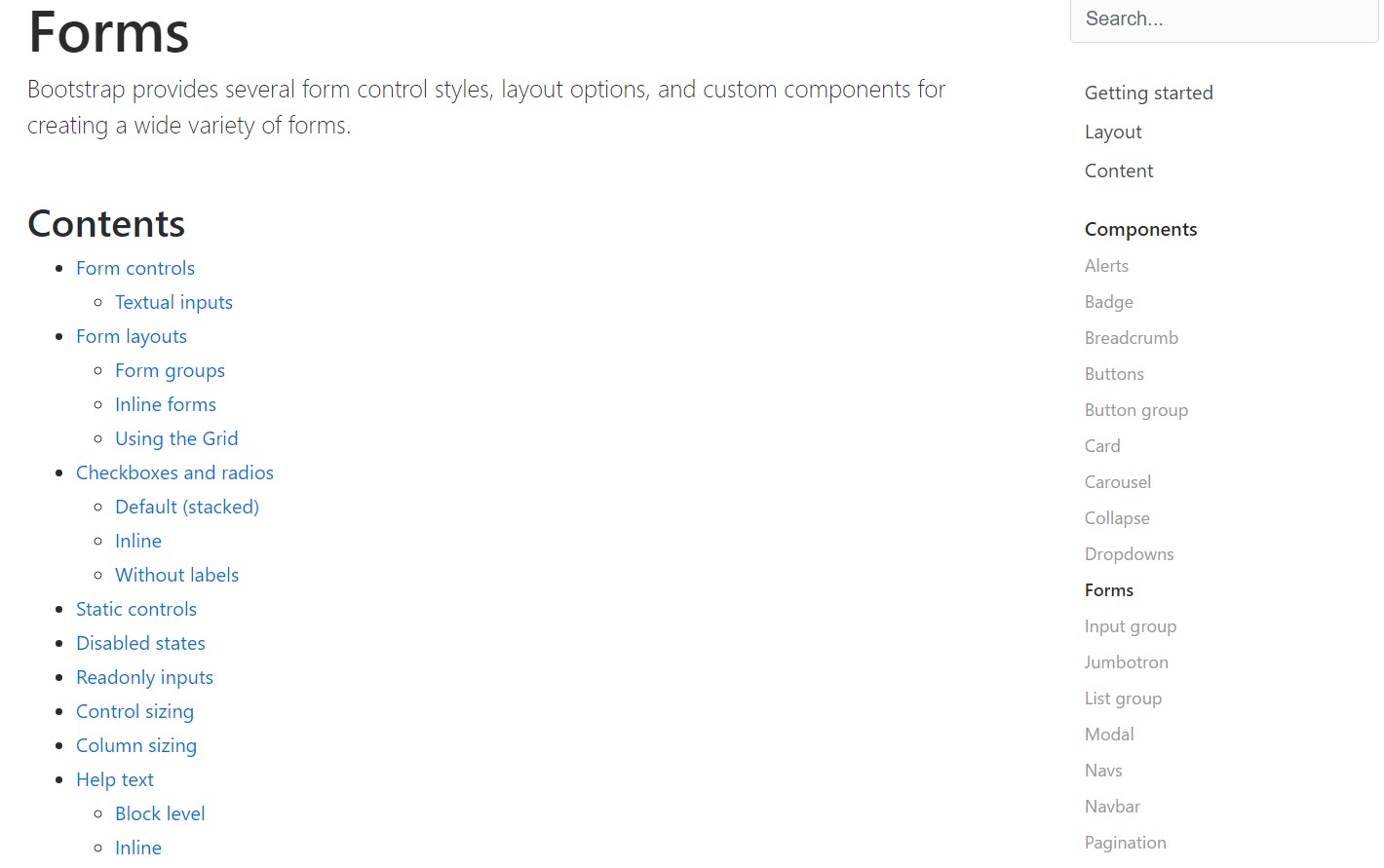
Bootstrap training

Support for Bootstrap Forms
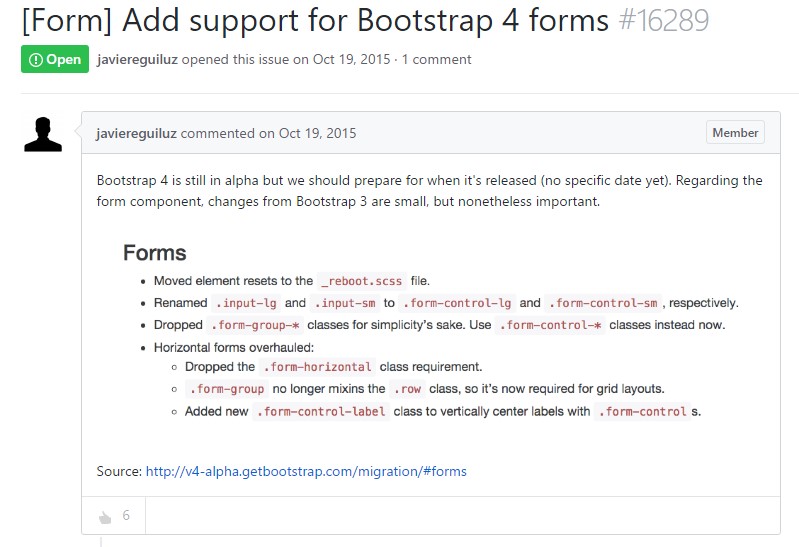
Why do not we look over AMP project and AMP-form feature?
